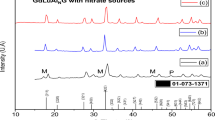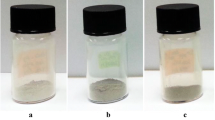Abstract
Exciton reflection and emission spectra and edge emission have been investigated in ZnS sinle crystals grown from the melt and containing oxygen and then subjected to annealing in vapors of the constituents. The study of optical properties of the crystals cooled to 77°K were conducted in parallel with structural investigations of the crystals using proton and x-ray diffraction analyses. Based on the experimental data it was concluded that in the ZnS lattice, oxygen exists in a number of phase states: as part of a ZnS·O solid solution in the host lattice; as a precipitate from the saturated solid solutionβ=ZnS·Osat; as an impurity atmosphere in the vicinity of packing faults; as ZnO precipitated on dislocations. The effect of oxygen in these various phase states on the exciton spectra and edge emission of ZnS was investigated. It was shown that oxygen is not very mobile in ZnS crystals annealed in sulfur vapor and it becomes concentrated mainly at packing defects. This leads to an increase in the concentration of packing defects and makes possible a transition from the cubic to the hexagonal modification of ZnS. The concentration of oxygen at packing defects leads to the appearance in reflection spectra and in the edge emission spectra ofα-ZnS of an additional hexagonal band located on the long wavelength side which is caused by the formation ofβ-ZnS·O solid solution. Oxygen diffuses quite rapidly through ZnS which has been annealed in zinc vapor and it precipitates from the crystals as the distinct phases ZnO orβ-ZnS · Osat, and as a result the defect content of the hostα-ZnS lattice decreases. The concentration of the ZnO-phase is quite small and its exciton bands do not appear in the reflection spectra. The precipitation of the solid solution in the form of the phaseβ-ZnS · Osat leads to the appearance of an additional long wavelength absorption edge in the 334 to 335 nm region (at 77°K). In addition, because single crystals of ZnS annealed in zinc vapor contain a large concentration of sulfur vacancies, there occurs a rather rapid formation of the solid solution on the layers ofα-ZnS close to the surface; this leads to a broadening and a shift toward longer wavelengths of the sphalerite exciton spectra. A similar shift is observed for the edge emission band ofα-ZnS. When the crystals are aged, theα-ZnS·O solid solution decomposes and the bands assume the standard sphalerite positions. Changes in the intensity of edge and exciton emission were investigated taking into account changes in the phase state of oxygen in the crystals.
Similar content being viewed by others
Literature cited
I. Uchida, J. Phys. Soc. Japan,19, No. 5, 670 (1964).
K. V. Shalimova and N. K. Morozova, Izv. Vyssh. Uchebn. Zaved., Fiz., No. 2, 98 (1964).
E. F. Gross, L. G. Suslina, and A. B. Mokerov, Fiz. Tverd. Tela,7, 291 (1965).
E. F. Gross, L. G. Suslina, and E. B. Shadrin, Fiz. Tverd. Tela,10, No. 4, 1036 (1968).
K. V. Shalimova, N. K. Morozova, O. I. Korolev, and M. M. Veselkova, Spectroscopy of Solids [in Russian], Vol. IV, Nauka, Leningrad (1969), pp. 192 and 202.
V. L. Levshin, É. Ya. Arapova, Yu. V. Voronov, and Yu. P. Timofeev, Zh. Prikl. Spektrsok.,12, No. 4, 674 (1970).
F. A. Kroger, Chemistry of Imperfect Crystals, North-Holland (1974).
A. M. Gurvich, Introduction to Chemical Crystallography [in Russian], Moscow (1971).
O. I. Korolev, Author's Abstract of Candidate's Dissertation, Moscow (1972).
M. M. Malov, Author's Abstract of Candidate's Dissertation, Moscow (1973).
N. K. Morozova, M. M. Malov, and O. I. Korolev, Izv. Akad. Nauk SSSR, Ser. Neorgan. Mat., No. 2, 220 (1972).
N. P. Golubeva and M. V. Fok, Zh. Prikl. Spektrosk.,7, 2 (1972).
E. Secco, J. Chem. Phys.,29, No. 2, 406 (1958).
G. H. Blount, P. B. Phipps, and H. Bube, J. Appl. Phys.,38, No. 11, 4550 (1967).
A. I. Ryskin et al., Zh. Éksp. Tekh. Fiz.,7, 335 (1968).
K. V. Shalimova, N. K. Morozova, and M. M. Veselkova, Zh. Prikl. Spektrosk.,22, No. 6, 1074–1081 (1975).
F. A. Kroger and G. M. Dickhof, J. Electrochem. Soc.,99, 4 (1952).
K. V. Shalimova, N. K. Morozova, M. M. Malov, and I. A. Karetnikov, Trans. of the Third All-Union Conference on Problems of AIIBVI Semiconductors [in Russian], Vilnius (1972).
Author information
Authors and Affiliations
Additional information
Translated from Izvestiya Vysshikh Uchebnykh Zavedenii, Fizika, No. 5, pp. 89–94, May, 1975.
Rights and permissions
About this article
Cite this article
Morozova, N.K., Malov, M.M., Veselkova, M.M. et al. Oxygen-phase-state changes in ZnS single crystals annealed in vapors of the constituents. Soviet Physics Journal 18, 672–676 (1975). https://doi.org/10.1007/BF00894002
Received:
Issue Date:
DOI: https://doi.org/10.1007/BF00894002




